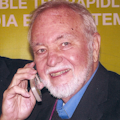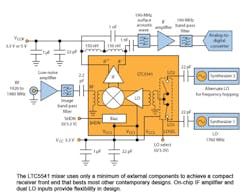Downconverting Mixers Lower Power Consumption While Improving Performance
Wireless basestation receivers are getting more difficult to design these days because of the major increase in high-speed data applications for cell phones. Video, Web browsing, gaming, and other demanding apps need 3G speeds to be successful. The one circuit that has the most effect on the receiver’s high-speed capability is the front-end mixer. More than ever, it needs greater linearity, wider bandwidth, lower noise, and greater dynamic range.
Linear Technology’s LTC554x family of mixers meets these demands in the 700-MHz to 4-GHz frequency range. These devices offer an outstanding input third-order intercept (IIP3) of 26 dBm, low noise figures of 9 to 10 dB, and high conversion gain of 8 dB. Their noise figure (NF) is typically 9.5 db. With 5-dBm blocking, their NF is 16 dB. These figures help achieve excellent dynamic range performance for both main receivers and digital pre-distortion receivers.
The LTC554x mixers also provide best-in-class capability to maintain a low NF in the presence of strong blocking interferers. This significantly enhances receiver sensitivity and robustness. Unlike other mixers in their class, the LTC554x devices operate on a single 3.3-V supply without compromising performance. This also reduces power consumption by 34% compared to the closest competitor.
Additionally, the LTC554x mixers satisfy the requirements of new 4G technologies such as Long-Term Evolution (LTE) cellular and WiMAX as well as 3G CDMA, WCDMA, TD-SCDMA, UMTS, and GSM/EDGE platforms (see the table). In addition, these mixers are a good fit for other wireless systems such as point-to-point microwave systems, cellular repeaters, public safety radios, and military communication systems.
The chip includes an integrated interface (IF) amplifier, local-oscillator (LO) buffer, LO switch, and RF balun transformers (see the figure). Each mixer’s RF input is single-ended, 50-Ω matched. Two single-ended LO inputs with high isolation are provided for frequency-hopping applications. Each LO input is also single-ended, always 50-Ω matched regardless of whether the mixer is active or powered down to avoid unlocking the phased-lock loop (PLL). The LO input requires only 0-dBm drive level.
The LTC554x mixers have identical pinouts, enabling designers to share printed-circuit board (PCB) layouts across multiple platforms operating in different frequency bands. This helps users reduce design costs and speeds time-to-market. The mixers’ pinouts are also similar to common industry footprints and pinouts, allowing ease of adoption while improving performance and reducing power consumption.
These devices draw a quiescent current of 200 mA. A power-down feature has turn-on and turn-off times of 2 µs and 3 µs, respectively. When disabled, the ICs consume a maximum of 500 µA. The mixers are offered in a 20-lead, 5- by 5-mm quad flat no-lead (QFN) surface-mount (SMT) package. Production is underway with the release of the LTC5541, followed by the LTC5543, LTC5540, and LTC5542. All products are sampling now and will be available in production quantities by February 2010. The LTC5541 starts at $6.50 each.
Linear Technology
www.linear.com
About the Author

Lou Frenzel
Technical Contributing Editor
Lou Frenzel is a Contributing Technology Editor for Electronic Design Magazine where he writes articles and the blog Communique and other online material on the wireless, networking, and communications sectors. Lou interviews executives and engineers, attends conferences, and researches multiple areas. Lou has been writing in some capacity for ED since 2000.
Lou has 25+ years experience in the electronics industry as an engineer and manager. He has held VP level positions with Heathkit, McGraw Hill, and has 9 years of college teaching experience. Lou holds a bachelor’s degree from the University of Houston and a master’s degree from the University of Maryland. He is author of 28 books on computer and electronic subjects and lives in Bulverde, TX with his wife Joan. His website is www.loufrenzel.com.
